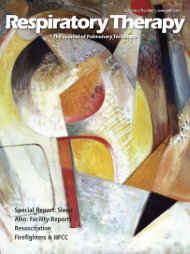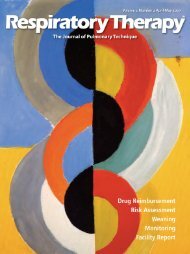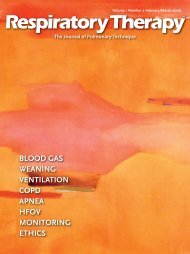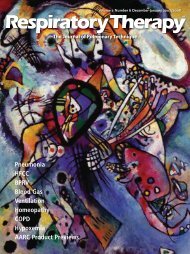RT 02-03 JJ07 main web - Respiratory Therapy Website
RT 02-03 JJ07 main web - Respiratory Therapy Website
RT 02-03 JJ07 main web - Respiratory Therapy Website
Create successful ePaper yourself
Turn your PDF publications into a flip-book with our unique Google optimized e-Paper software.
Figure 1<br />
Supine tidal flow-volume curves (control and during NEP of -5 cmH 2O)<br />
and corresponding expiratory flow-time curves (only during NEP) in<br />
representative subjects of the different groups. The hatched areas<br />
under the flow measure the volume exhaled in the first 0.5 sec.<br />
(V,NEP 0.5) and 1 sec. (V,NEP 1) after NEP application.<br />
been found to be greater in OSAH patients, possibly influencing<br />
its collapsibility. 20,21<br />
Hence, several, concurrent, inter-related mechanisms (increased<br />
compliance, decreased transmural pressure, smaller size and<br />
greater length of the upper airways) might enhance the<br />
pharyngeal collapsibility in patients with OSAH.<br />
Therefore, simple assessment of upper airway mechanics during<br />
wakefulness could identify OSAH subjects and select them for<br />
standard polysomnography. In normal awake subjects the<br />
application of small negative expiratory pressure (NEP)<br />
transients at the onset of resting expiration does not elicit reflex<br />
activity of the genioglossus nor changes in upper airway<br />
resistance per se. 22,23 Under these conditions, the flow dynamics<br />
at the beginning of the expiratory phase during NEP application<br />
are expected to reflect the mechanical behavior of the<br />
pharyngeal airway in a “quasi-passive” condition even during<br />
wakefulness. Accordingly, the aim of our study was i) to<br />
investigate if volume exhaled during early application of NEP at<br />
the onset of quiet expiration at rest was different in OSAH<br />
patients, snorers and normal subjects, suggesting different<br />
degrees of pharyngeal collapsibility among these groups and ii)<br />
if these differences could be used to distinguish non-apneic<br />
from apneic snorers.<br />
Methods<br />
Subjects: In a prospective, randomized study we investigated at<br />
the Division of Pneumology of the S. Orsola-Malpighi Hospital<br />
of Bologna the early expiratory flow dynamics after the<br />
application of a small (-5 to -7 cmH 2O) negative pressure at the<br />
mouth in 48 awake male subjects coming from the Neurology<br />
Unit who had performed a polysomnographic study in the Sleep<br />
Center because of suspected sleep disordered breathing. We<br />
excluded those with obvious anatomical defects such as craniofacial<br />
and/or severe otorino-laryngoiatric (ORL) abnormalities,<br />
or with neurological and endocrine diseases known to be<br />
causally associated with SDB. Subjects affected by cardiac and<br />
respiratory disorders capable of causing intra-thoracic tidal<br />
expiratory flow limitation (EFL) were also excluded, as well as<br />
obese subjects with tidal intra-thoracic EFL in either position.<br />
Subjects were not treated with drugs active on CNS or suffered<br />
from chronic alcoholism. Among the enrolled subjects 34<br />
resulted affected by obstructive sleep apnea-hypopnea (OSAH)<br />
and 14 were snorers without OSAH (Sn). Seven male subjects,<br />
non-apneic, non-snorer, as assessed by nocturnal<br />
polysomnography, were recruited from the Hospital staff as<br />
controls. The study was approved by the local Ethics<br />
Committee and an informed consent was obtained from each<br />
subject.<br />
Study design – Sleep study: All subjects were examined at the<br />
Sleep Center performing an overnight polysomnographic study<br />
by recording the following parameters: nasal pressure (by nasal<br />
cannula), oral flow (by thermistor), abdominal and rib cage<br />
movements (by piezo-sensors), oxygen saturation and heart rate<br />
(by finger oxymeter), snoring (by microphone), body<br />
movements and body posture. <strong>Respiratory</strong> events were defined<br />
as obstructive apnea in the presence of nose and mouth airflow<br />
cessation for at least 10 sec with concomitant inspiratory efforts<br />
and as obstructive hypopnea in the presence of discernable<br />
inspiratory airflow reduction with inspiratory efforts<br />
accompanied by a decrease of >3% in oxygen saturation. The<br />
results were expressed as the number of apnea and hypopnea<br />
per hour of sleep (apnea-hypopnea index, AHI). 24 The subjects<br />
were categorized according to AHI as non-apneic snorers (AHI ≤<br />
5) and snorers with mild-to-moderate (AHI 5) or<br />
severe (AHI ≥ 30) OSAH.<br />
NEP testing: Subsequently, the subjects were sent to the<br />
Division of Pneumology to evaluate the upper airway mechanics<br />
looking at the flow-time relationship in the early tidal expiration<br />
during strict wakefulness. Expiratory flow dynamics was<br />
assessed during the application of a negative expiratory<br />
pressure at the mouth (NEP technique). NEP was applied<br />
randomly at two different levels, i.e. -5 cmH 2O and -7 cmH 2O,<br />
initially in the seated position and later, 10 minutes after<br />
assuming the supine posture. In both positions and at both<br />
levels of negative pressure, at least 5 NEP breath-tests were<br />
performed at intervals of 5–10 respiratory cycles, always when<br />
the patient had resumed regular breathing according to the<br />
spirogram that was continuously displayed on the computer<br />
monitor. In this respect, great care was placed to check the level<br />
of the end-expiratory lung volume. The expiratory flow<br />
recorded under each NEP application was measured in the first<br />
0.5 and 1 sec from the onset of NEP administration to compute<br />
by time integration the volume exhaled in these time intervals,<br />
labeled hence fore V,NEP 0.5 and V,NEP 1, respectively (Fig. 1). For<br />
all subjects in each experimental condition (different posture<br />
and negative pressure levels) the mean value of V,NEP 0.5 and<br />
64 <strong>Respiratory</strong> <strong>Therapy</strong> Vol. 2 No. 3 � June-July 2007











